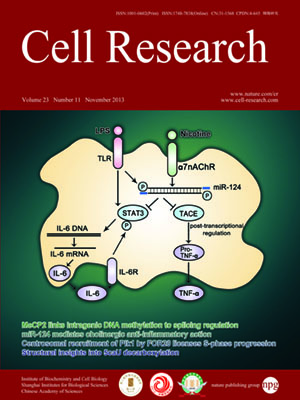
Volume 23, No 11, Nov 2013
ISSN: 1001-0602
EISSN: 1748-7838 2018
impact factor 17.848*
(Clarivate Analytics, 2019)
Volume 23 Issue 11, November 2013: 1256-1269 | Open Access
ORIGINAL ARTICLES
Intragenic DNA methylation modulates alternative splicing by recruiting MeCP2 to promote exon recognition
Alika K Maunakea1,2,*, Iouri Chepelev1,3,*, Kairong Cui1 and Keji Zhao1
1Systems Biology Center, National Heart, Lung and Blood Institute, NIH, Bethesda, MD 20892, USA
2Current address: Department of Native Hawaiian Health, John A. Burns School of Medicine, University of Hawai`i at Manoa, Honolulu, HI 96813, USA
3Current address: Center for Autoimmune Genomics and Etiology, Cincinnati Children's Hospital Medical Center, Cincinnati, OH 45229, USA
Correspondence: Keji Zhao, Tel: +1 301 496 2098; Fax: +1 301 480 0961(zhaok@nhlbi.nih.gov)
Although the function of DNA methylation in gene promoter regions is well established in transcriptional repression, the function of the evolutionarily conserved widespread distribution of DNA methylation in gene body regions remains incompletely understood. Here, we show that DNA methylation is enriched in included alternatively spliced exons (ASEs), and that inhibition of DNA methylation results in aberrant splicing of ASEs. The methyl-CpG-binding protein MeCP2 is enriched in included ASEs, particularly those that are also highly methylated, and inhibition of DNA methylation disrupts specific targeting of MeCP2 to exons. Interestingly, ablation of MeCP2 results in increased histone acetylation and aberrant ASE-skipping events. We further show that inhibition of histone deacetylase (HDAC) activity leads to exon skipping that shows a highly significant degree of overlap with that caused by MeCP2 knockdown. Together, our data indicate that intragenic DNA methylation operates in exon definition to modulate alternative RNA splicing and can enhance exon recognition via recruitment of the multifunctional protein MeCP2, which thereby maintains local histone hypoacetylation through the subsequent recruitment of HDACs.
10.1038/cr.2013.110
FULL TEXT | PDF
Browse 2536


